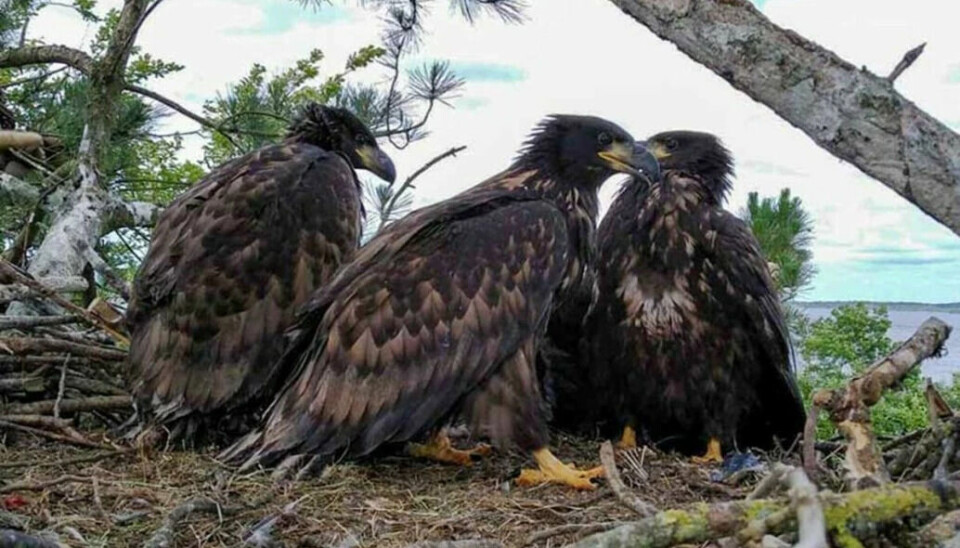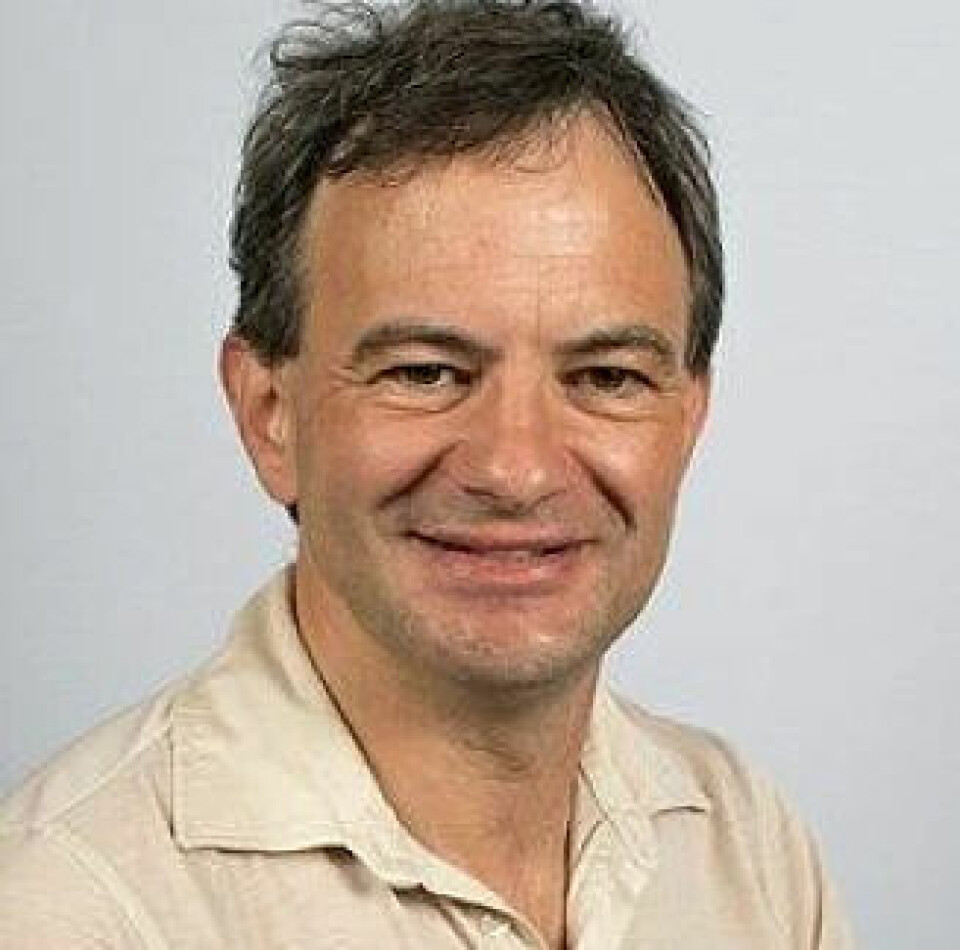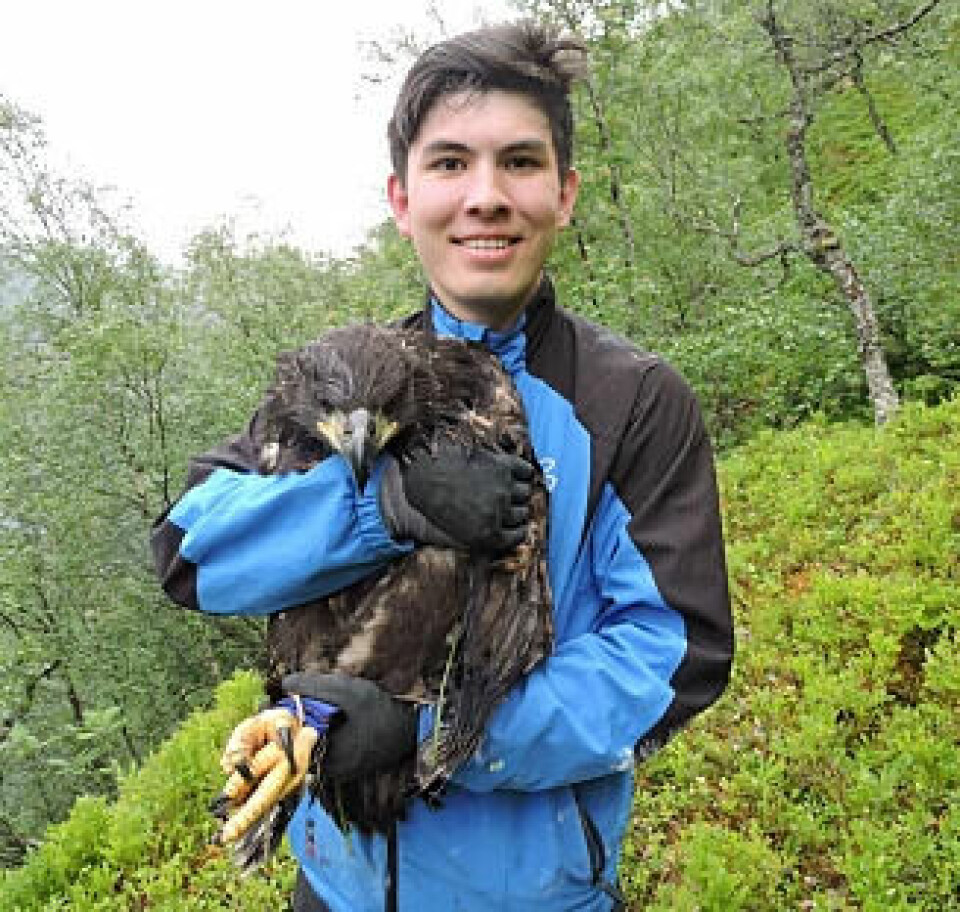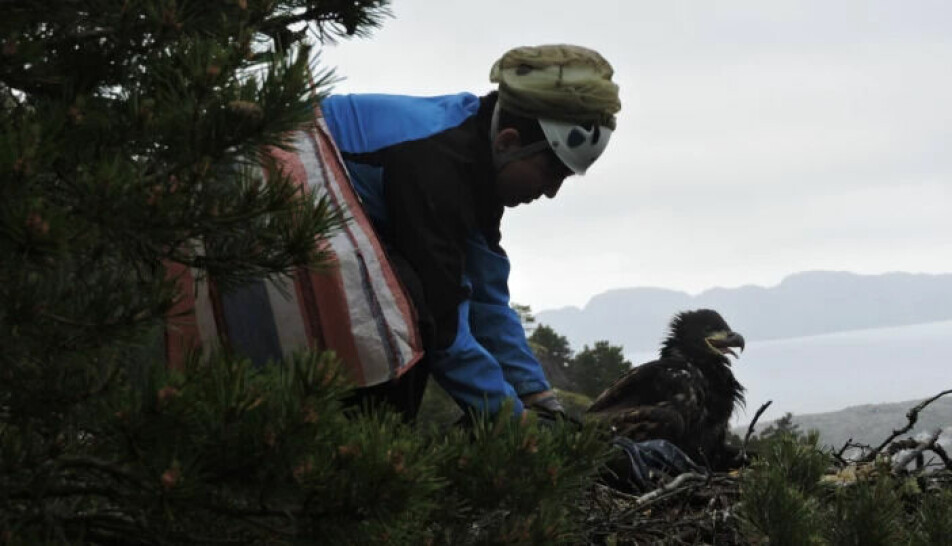
Record numbers of Norwegian sea eagles are exported to Europe
Norwegian authorities exported a record number of white-tailed sea eagle chicks this summer. They are hatching new, viable populations in Ireland, Spain and Scotland.
Norway has Europe's largest nesting population of white-tailed sea eagles.
The population is now so large and viable that the Scandinavian country can help other European countries that want the species back on their own coasts.
This summer, researchers sent a record number of white-tailed sea eagle fledglings abroad.
New record in sea eagle exports
A total of 35 chicks have been exported this summer.
“We have sent 16 fledglings to Ireland and 19 to Spain,” Duncan Halley at the Norwegian Institute for Nature Research (NINA) tells sciencenorway.no.
This is the largest amount thus far in the project.
“It has been busy and extra demanding because we had to isolate all the birds due to the risk of bird flu. All tested negative in Norway before export,” Halley says.
Frøya is one of the best areas

The chicks are taken from nests along the northwest coast of Norway, in particular the counties of Trøndelag and Møre og Romsdal. Many have been collected from the island Frøya.
This is because most of the eagles there hatch on the ground instead of on cliffs or in tall trees, which makes it easier to capture them.
It is time-consuming to find suitable nests because there must be at least two eggs in the nest before they can remove one.
“We must have examined about 200 nests to find enough chicks,” Halley says.
Dependent on volunteers
The chicks are between six and nine weeks old when they are removed from the nest. This is the ideal age.
“At this age, they are big enough to find food themselves, but they can’t fly yet,” Halley says.
The researchers receive assistance from volunteers who know where the nests are.
“We depend on and are very grateful for the help we get from the volunteers who have assisted us,” Halley says.
The chicks are quarantined in a cage for 40 days before being released into the wild.
Ceremonial release

On the 9th of August, there will be a ceremonial release of white-tailed sea eagle fledglings in Ireland. The Norwegian ambassador will participate in the event.
At the very beginning, they will be fed near the area in which they were released, to ensure their survival.
So far, exports to Ireland have been a success.
“There are about ten pairs of nesting eagles there now, originally from Norway, and over 40 chicks that have left their nests in Ireland,” says Halley.
The white-tailed sea eagle only becomes sexually mature when it is five years old, so it takes time to build up a viable population.
Success in Scotland
In Scotland, Norwegian white-tailed sea eagles have successfully established themselves.
“There is now very rapid growth over there,” says Halley.
170 breeding pairs are descendants of Norwegian eagles. The growth in the population indicates that there will be approximately 900 pairs in Scotland by 2040.
“Each couple has an average of 0.67 surviving young, which is also the norm in Norway,” he says.
According to the plan, 50 Norwegian white-tailed sea eagles are to be sent to Ireland over a five-year period starting in 2020.
The Norwegian white-tailed eagle has also built up and strengthened the populations of sea eagles in Scotland and Spain.
Sea eagle chicks are sent by charter plane from Trøndelag
Up until a few decades ago, white-tailed sea eagles were also endangered in Norway. However, the population recovered significantly as a result of conservation in 1968.
Other European countries have not prioritised conservation until quite recently.
Last summer, ten chicks were caught in Trøndelag and sent by plane across the North Sea. They were between seven and ten weeks old.
All the white-tailed sea eagle chicks sent abroad are equipped with a tracking mechanism, so the researchers can see where they move.

Norwegian eagle couple had triplets
Last year triplets were hatched in Ireland by a pair of Norwegian eagles, according to NINA.
It is rare to have three white-tailed sea eagle chicks in one brood, even in Norway.
The white-tailed sea eagle project was set up as a result of an Irish initiative in 2007. The aim was to reintroduce a viable sea eagle population.
From 2007 to 2011, 100 chicks were taken from nests along the Trøndelag coast and flown to a new life in Ireland.
In 2020, a replenishment project started. Fifty new young birds will provide a long-awaited addition to the Irish population over a five-year period.
So far, this project has been a success, according to NINA (link in Norwegian).
The work is a collaboration between landowners, NINA and the Norwegian Environment Agency.
Not a threat to the Norwegian population
According to the Norwegian Environment Agency the export in no way threatens the Norwegian population of white-tailed sea eagles.
But the work is time-consuming. Only one in five pairs of eagles have more than one young per year.
The history of white-tailed sea eagles in Norway shows that it is useful to take measures for species diversity.
“It is very gratifying that we have gone from an endangered population to being able to export a surplus of young fledglings to bring the white-tailed sea eagle back to countries where they disappeared,” Hambro told NTB (link in Norwegian).
Problems with poisoning
An early threat to the success of the reintroduction was poisoning of eagles when they ate carcasses of sheep that had been laced with poison by farmers.
Four eagles died from poisoning in 2008. The farmers were, however, attempting to kill foxes, crows, and ravens.
The method was illegal, but had not been noticed by the public until radio-tagged eagles were found dead.
The Norwegian ambassador, Øyvind Nordsletten, appealed to the Irish government and people for action on the issue. The Irish parliament tightened the law the next year and made all use of poison outdoors, and all use of poisoned meat baits anywhere, illegal.
Since 2015 there have been no reported poisonings.
Farmers monitor birds and nests
Initially, some sheep farmers were worried about their lambs. Public meetings and demonstrations were held - but the farmers' view of the eagles has changed, according to the Irish newspaper Agriland.
This was because the released eagles did not kill any lambs, and because of extensive work to improve the relationship between birds of prey and farmers.
Farmers are informed by researchers if the birds settle nearby with the help of tracking devices, NINA states.
Now farmers contribute to the project by monitoring birds and nests.
To Scotland from Nordland
Scotland already started its conservation work in the 1970s. Currently 150 pairs nest there.
This population is now so large that descendants of Norwegian birds are used in England's first reintroduction on the Isle of Wight on the south coast.
Spain started last year
The Norwegian white-tailed sea eagle is also the foundation of a new population in Spain. Specifically on the Atlantic coast in the north of the country.
The project started in 2021, and you can follow it on the Facebook page Proyecto Pigargo.
The plan is to release 20 birds this year and more after that. In the long term, the white-tailed sea eagle will reconquer the entire Atlantic coast down to Gibraltar.
———
Translated by Alette Bjordal Gjellesvik.
Read the Norwegian version of this article on forskning.no
Sources: NTB, Nationen and NINA
This article was updated on 25 August 2022 at 16:41. The original text stated that white-tailed sea eagles had been killed by farmers in Ireland who put out poisoned bait. This was incorrect - the poisoned bait was not aimed at the eagles but inadvertently killed some of them. Some information was added to explain what actually happened, and how the situation was resolved.
































